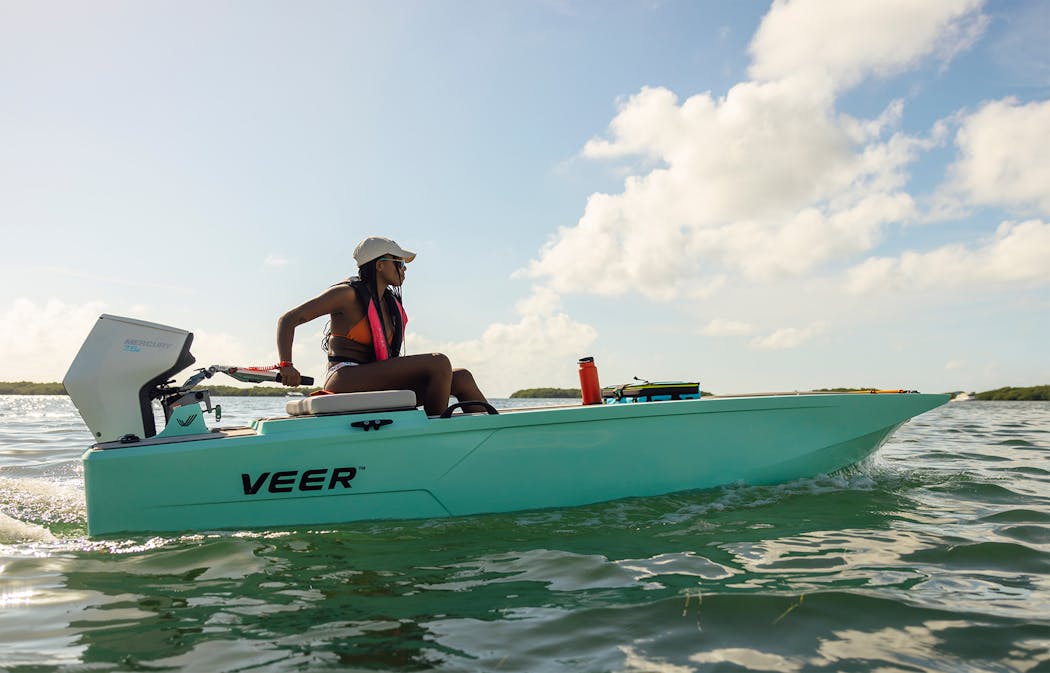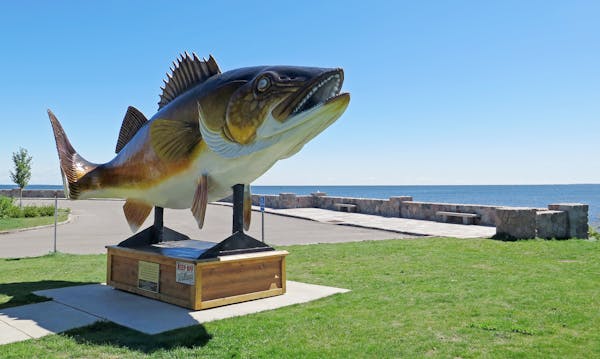Sport shows
Northwest is back for the dreamers
Though winter seems unwilling to loosen its icy grip on Minnesota, summer's warm breezes and blue water are as near this weekend as the Minneapolis Convention Center, where the Discover Boating Northwest Sportshow beckons all who dream of cruising shorelines, casting lures or vacationing in a cabin up north amid towering pines and cobalt skies.
Show highlights include expert angling seminars and demonstrations, a trout pond for kids of all ages, do-it-yourself maintenance tips for boat owners, "create a crankbait" opportunities for young anglers, and scores of U.S. and Canadian resorts and outfitters tantalizing showgoers with camping, paddling and other adventure opportunities.
Boats, of course, will be everywhere, including innovations that a few years ago existed only in engineers' dreams.
Veer, a new brand of watercraft designed by Lund Boats of New York Mills, Minn., is one example. Its V13 model, starting at $12,000, is an entry-level rotomolded craft that can be trailered or carried in the back of a pickup truck. Models will be available at Rapid Marine outlets this spring. Power options include a Mercury 9.9 horsepower outboard (Lund and Mercury are owned by Brunswick), and coming soon, also from Mercury, an electric option, the Avator 7.5e.
No stranger to innovation, Alumacraft of St. Peter, Minn. — owned by BRP, manufacturer of Ski-Doo snowmobiles and Can-Am ATVs — is scheduled to unveil this year its boats rigged with "semi-submerged" Rotax S115- and S150-horsepower outboards. The Rotax outboard technology, deployed since 1962 in Ski-Doo snowmobiles, will be displayed at the show on Manitou pontoons, also a BRP brand.
BRP says the new outboards are quiet, fuel-efficient and, importantly, free up space for outsized boat aft decks. Some Alumacraft models have been redesigned to highlight this feature.
The Discover Boating Northwest Sportshow continues through Sunday. Hours Friday, March 10 at the Minneapolis Convention Center are noon-8 p.m.; Saturday, 10 a.m. to 7 p.m.; and Sunday, 10 a.m. to 5 p.m.
Tickets are available online only. Adults are $15, with kids 12 and younger free with a paid adult. More at northwestsportshow.com.
Legislative update
Movement at the Capitol
A big bonding bill important to hunters and anglers passed the Minnesota House of Representatives this week, a promising development as work continues on other outdoors-related proposals.
Rep. Rick Hansen, DFL-South St. Paul, said the legislation received 10 more votes than it needed for passage — a showing of bipartisanship that he hopes will carry over to the Senate, where Democrats barely outnumber Republicans. Hansen chairs the House Environment and Natural Resources Finance and Policy committee.
The bonding bill would appropriate $66 million to the Department of Natural Resources to rebuild the Waterville Fish Hatchery, improve the Badoura State Forest Nursery and preserve other DNR assets.
Also of high importance is the DNR's budget bill, presented to Hansen's committee this week. There are more than $200 million in one-time investments proposed in the bill, including several initiatives for improving forests, enhancing grasslands, restoring wetlands, upgrading habitat on public hunting land, fixing fishing infrastructure and upgrading camping areas and trails.
A critical component of the bill would increase fees for fishing, state park admittance and boat registration, raising an estimated $20.4 million a year.
Hansen said bills to fight contaminants and battle the spread of chronic wasting disease in deer also are getting attention. DNR Commissioner Sarah Strommen has testified that the disease "is an incredible concern" to Minnesota.
Wildlife
Eagles online — and all about
The lives of a raptor family playing out in real-time on Minnesota's popular EagleCam are news-filled this time of year. Like life, they have darkness and light.
The appearance of the first egg in the nest Feb. 15 was met with rapturous joy on places like the Facebook page geared to followers of the EagleCam. Then a second egg appeared and, most recently, evidence came Feb. 28 that one of the eggs broke.
Lori Naumann sees and monitors these eagles up close in her role in the Nongame Wildlife Program of the DNR. But she thinks about the wider state eagle population, too — one that is healthy at the moment despite myriad human-made threats — and the opportunities to observe them elsewhere.
Where there is constant access to water and subsequently fish this time of year, like Red Wing, Reads Landing and Wabasha for example, you'll likely see the majestic birds in action.
The EagleCam, in its 10th year, continues to attract followers, whatever the reason. Naumann recalled a noticeable spike in clicks during the COVID pandemic as screen time ramped up. Then there are images like those from this Feb. 23: heavy snow buried an eagle parent to its neck as it incubated the eggs in the 8-foot-wide nest. The image turned up everywhere, including the Star Tribune's Instagram.
Hundreds of millions of people were exposed to the image or news of the image since that snowstorm, according to software that tracks the EagleCam's audience.
Naumann said the viral image brought in donations, too, from some of those viewers to the Nongame Wildlife Program — the intent of the EagleCam from the start. The program also brings in donations during the tax-filing season through the nongame tax checkoff.
She and the Nongame staff continue to learn, too, about eagle behavior through the lens on the nest. To wit, ever-adapting, breeding eagles are nesting closer to one another than previously thought and seen, Naumann added.
"[Their actions are] interesting to see … we think of it as sort of accidental research."
Bicycling
Getting ready to roll
Observe a bike line or a trail: Minnesotans cycle year-round for sport and, well, for life. In that context, March is a key time for people to learn bike basics or consider the months ahead with opportunities to ride on a variety of dry surfaces.
It's the role of the advocacy group Bicycle Alliance of Minnesota, or BikeMN, and its state chapter colleagues to get Minnesotans enthusiastic about those possibilities. BikeMN launches its event season with the Lake Alice 100 on May 13 in Fergus Falls which reflects the nonprofit's all-comers ethos.
The Lake Alice 100, in its 10th year, is a free ride. Participants can ride one lap around Lake Alice or shoot for more (perhaps an 87-lap century?). Every rider who completes a lap gets a raffle ticket to a drawing for $100 in cash to mark the ride's anniversary.
Some of BikeMN's other rides include the Tour of Saints in the St. Joseph area (July); Rock-n-Roll the Lakes in Albert Lea (August); the Rosewood Gramble gravel ride in Thief River Falls and the St. Paul Classic (September); and the Mankato River Ramble (October).
Need to break off some rust or get educated? BikeMN has a regular series of workshops around cycling essentials. A two-hour bike maintenance class is in Minneapolis on March 16.
"We just want to inspire people to keep using bikes, walking, and all the good things that come with that," said Ted Duepner, BikeMN supporter relations manager.
BikeMN is partners with Bicycling Around Minnesota (BAM), which is back this August and already waitlisted. BAM, a cycle tour fixture since 2006 that was last held in 2019, hit its 275-rider cap a month after registration opened, but organizers are encouraging people to get on the waitlist.
This year's ride from Aug. 17-20 is over the uplands and into the valleys of southeast Driftless Area and will touch Rushford, La Crescent, Houston and Lanesboro. BAM draws about half of its participants from Minnesota, including riders from 23 countries and Canada.
Ice-out
Predict the spring thaw
The director of Minnesota Sea Grant, a University of Minnesota-based program focused on water science, has created a tool to help the user predict ice-out dates for state lakes.
John A. Downing wrote online that he was inspired to create the Minnesota Lake Ice-In and Ice-Out Widget "so my friends, colleagues and family could better plan for spring activities … when I can put my boat in the lake. I know that I am not alone."
Raising the impact of climate change and weather variability, Downing notes ice-out now can be plus or minus seven weeks in the northern half of Minnesota. Well-documented data from the Department of Natural Resources shows the average ice-out date for lakes up north is April 24, but it has been as early as late March and as late as mid-May. He told the Star Tribune early ice-outs have crept up by five weeks "and that has to do with how weather gets delivered to us."
Downing does an accessible job of walking Sea Grant online readers through the science of weather and its impact on lake ice, with thawing and freezing degree days data and probability curves. Bottom line: it's an interesting approach to estimating the spring thaw, and he is hopeful it is a useful tool.
"There is a real, practical impact of variation that we see in weather," he said Thursday. "That is what I am going for [by creating the widget.]"
Downing will talk about his project and do some forecasting in an online seminar at noon March 15. Registration is required.
He added an important footnote online: "This widget does NOT determine when ice is safe for you!"
Fishing
Muskie Expo at the State Fairgrounds
A different kind of Monster of the Midway will be displayed this weekend at the Muskie Expo, held at the Minnesota State Fairgrounds' Warner Coliseum. Joined by the Minnesota Anglers Boat Show, the expo this year claims to be the biggest Esox masquinongy gathering ever, with 50,000 square feet and 60 booths stuffed with "nothing but muskie."
Muskie experts including Jim Saric, Mike Keyes, Gregg Thomas, Luke Ronnestrand and Doug Wegner will lead seminars discussing everything from tackle and tactics to fishing electronics. Kids can design and build their own muskie lures to take home free. And everyone who attends will be entered in a drawing for tackle and a guided day of muskie fishing.
In its 30th year, the show is held in honor of its founder George Wahl. Hours Friday, March 10 are 2-8:30 p.m.; Saturday, 10 a.m.-6:30 p.m.; and Sunday, 10 a.m.-4 p.m. Admission is $10 daily or $17 for all three days. Kids 12 and younger are free, as is parking.
New regulations pay respect to gar
Minnesota continues to blaze a trail to sustainably manage rough fish, adding a bag limit on gar as part of the 2023 state fishing regulations.
Previously, the toothy, prehistoric fish that is native to Minnesota waters could be kept in unlimited numbers by spearers, anglers and bowfishers. A campaign to protect them and other rough fish received a boost several years ago when a YouTube video showed a slaughter of gar by a small group of Minnesota spearers on river ice.
The gar regulation was formed because the Legislature got involved in the issue in 2021. The limit of 10 applies to longnose and shortnose gar. Other native rough fish receiving consideration for new protections include buffalo, redhorse, freshwater drum, bowfin, goldeye and bullhead.
Shannon Fisher, fisheries monitoring and regulations manager at the DNR, has said the agency must learn more about those species before setting bag limits. But in the big picture, he said, they contribute to the ecological health of rivers and lakes. If the steps continue, Minnesota could be seen as a leader in conserving native species that were once considered "junk" fish.
Bird migration
Time to clean out wood duck boxes
To welcome wood ducks that will be arriving soon in Minnesota, conservationists should plan now to clean out the special houses they've placed near wetlands and other key locations to facilitate successful nesting by these unique waterfowl.
Old nests and other bedding and debris should be removed from the boxes and replaced with new bedding. This is important because wood ducks can't carry nesting materials to establish their own nests.
Proper placement of wood duck boxes is essential, as is making them predator-proof. More information, including details about how to make your own wood duck boxes designed by the late Don "The Duckman" Helmeke, are available from the Wood Duck Society.
Hunting
Elk permits inching upward
Minnesota hunters should receive information by mid-May on elk season dates and permit availability for 2023, DNR Big Game Leader Barb Keller said.
She said the agency is considering issuing more permits than the 30 that were issued in 2022, while possibly expanding the hunting boundaries in the Kittson County Central area by moving the line six miles to the west and three miles to the south. The expansion would keep up with movements of the Central herd, now estimated at 75 animals.
Every year, DNR conducts an aerial population survey of the three herds that it manages in northwestern Minnesota. This year's biggest change was a sizable increase in the cross-border herd that straddles Minnesota and Manitoba.
For the first time in the survey's history, Keller said, the DNR was allowed to fly over the Manitoba portion of the herd's territory. The crew counted 131 elk in Manitoba and another 96 on the Minnesota side for a total of 227. That compares to 2018's total count of 133 elk. The animals roam indiscriminately back and forth over the border.
Based on the new snapshot, DNR may increase hunting permits in the area from the recent norm of two bull licenses per year. That's because the population goal assigned to the herd is 150 to 200.
The Kittson County Central herd, where 28 hunting permits were issued last year, continues to be above its population goal of 50 to 60, Keller said.
The third elk herd managed by DNR is the smallest and hasn't been hunted for a decade. It's located in the Grygla, Minn., area with a count of 29 elk in each of the last two years.

The PWHL's growth comes with a price for a Minnesota Frost team building a potential dynasty.
What is the 'House settlement,' and what does it mean for the Gophers and NCAA?

Souhan: Anxiety and depression in the NFL helped inspire Lindsey Young's children's book

Reusse: Country boy Jim Marshall never lost his lust for life





